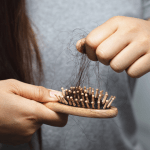Defining Unwanted Hair Growth
Unwanted hair growth, medically termed hirsutism, is a condition characterized by the excessive growth of dark, coarse hair in areas typically associated with male patterns of growth. This includes regions such as the upper lip, chin, chest, abdomen, and back. While the presence of fine, light hair, known as “peach fuzz,” is normal in these areas, hirsutism is distinguished by the growth of hair that is more similar to terminal hair found on the scalp and pubic area. Hirsutism affects between 5% to 10% of women and people assigned female at birth (AFAB) during their child-bearing years and can persist or emerge during menopause.
Psychological Impact of Hirsutism
The presence of unwanted hair can have a profound psychosocial and psychological impact on individuals. The societal and cultural emphasis on hairlessness as a standard of beauty can lead to significant emotional distress, including feelings of anxiety, depression, and a diminished sense of self-esteem. The condition can affect personal relationships and social interactions, leading to a withdrawal from social activities and a decreased quality of life. It is crucial to acknowledge and address these psychological effects when considering treatment options.
Scope of the Article
This article aims to explore the multifaceted issue of unwanted hair growth during menopause, delving into the underlying causes, psychological implications, and various management strategies. We will examine the hair growth cycle, the hormonal changes that occur during menopause, and their effects on hair growth patterns. Additionally, we will discuss both natural and professional hair removal techniques, offering insights into their effectiveness and suitability. Recognizing when to seek medical advice will also be a critical component of our discussion, as will the importance of making informed choices that align with personal preferences and health considerations. Ultimately, our goal is to empower individuals experiencing menopausal hirsutism to embrace change with patience and persistence, while navigating the complex landscape of self-perception and beauty standards.
Understanding the Hair Growth Cycle
Anagen, Catagen, and Telogen Phases
The hair growth cycle is a complex process that involves three distinct phases: anagen, catagen, and telogen. Each phase plays a critical role in the development, renewal, and shedding of hair.
Anagen Phase: Known as the growth phase, anagen is the period during which hair actively grows. This phase can last between two to six years and determines the length of our hair. During anagen, cells in the root of the hair divide rapidly, adding to the hair shaft. At any given time, about 90% of the hairs on our scalp are in the anagen phase.
Catagen Phase: Following the anagen phase, the hair enters the catagen phase, which is a transitional stage that lasts about two weeks. During this time, the hair follicle shrinks and detaches from the dermal papilla, a structure critical for hair growth. Approximately 3% of all hairs are in this phase at any one time.
Telogen Phase: The final phase is the resting phase, where the hair does not grow but remains attached to the follicle. After about three months in the telogen phase, the hair will eventually shed, and a new hair begins the growth cycle anew. Typically, 10-15% of hairs are in this phase. It’s normal to shed between 50-100 telogen hairs a day as part of this natural cycle.
Differences Between Vellus and Terminal Hair
Not all hair is created equal. The human body has two types of hair: vellus and terminal.
Vellus Hair: These are the short, fine, and light-colored hairs that often go unnoticed. They are commonly referred to as “peach fuzz” and are found on most areas of the body. Vellus hair plays a role in regulating body temperature and is not as heavily influenced by hormonal changes.
Terminal Hair: This type of hair is longer, coarser, and usually darker than vellus hair. Terminal hairs are found on the scalp, eyebrows, legs, arms, and pubic region, as well as facial hair in men. During puberty, hormonal changes cause vellus hair to transform into terminal hair in certain areas of the body.
Understanding the hair growth cycle and the types of hair is essential for recognizing normal hair growth patterns and identifying when there may be a cause for concern, such as in cases of hair loss or hirsutism. By maintaining a healthy scalp environment and seeking medical advice when necessary, individuals can better manage their hair growth and overall hair health.
Hormonal Changes During Menopause and Their Effects
Role of Estrogen and Testosterone in Hair Growth
Hair growth is significantly influenced by hormonal activity in the body, particularly by estrogen and testosterone. Estrogen, often referred to as the female hormone, is known to promote the growth and fullness of hair. It helps in prolonging the anagen phase, or the growth phase of the hair cycle, leading to denser and more robust hair. On the other hand, testosterone, which is present in lower levels in women, can be converted to dihydrotestosterone (DHT) by the enzyme 5α-reductase. DHT has a miniaturizing effect on hair follicles, especially in genetically predisposed individuals, potentially leading to hair thinning and loss.
How Menopause Alters Hormone Levels
During menopause, the body undergoes a significant hormonal shift. The ovaries reduce their production of estrogen and progesterone, leading to a decrease in these hormones’ levels. This reduction disrupts the delicate hormonal balance that once promoted hair growth and maintenance. Although the production of androgens such as testosterone may not increase, the lower levels of estrogen and progesterone mean that androgens have a more pronounced effect on the body. This hormonal imbalance can alter the hair growth cycle, causing some terminal hairs to become thinner and vellus hairs to become coarser and more noticeable.
Typical Areas Affected by Hirsutism in Menopause
Menopause can lead to a condition known as hirsutism, which is characterized by the growth of coarse, dark hair in areas where women typically do not have terminal hair growth. The most common areas affected by hirsutism during menopause include the face (particularly the upper lip and chin), chest, back, and abdomen. This unwanted hair growth is not only a cosmetic concern but can also have a psychological impact, affecting self-esteem and quality of life. While the prevalence of hirsutism in menopausal women in the United States is about 10%, those who do experience it can seek various treatments to manage the condition.
In conclusion, menopause brings about hormonal changes that can lead to unwanted hair growth due to the altered balance between estrogen and testosterone. Understanding these changes is crucial for managing the effects and seeking appropriate treatment options.

Do you have the most commonly used but toxic, disease bringing chemicals in your skin care? Many chemicals in skincare are hormone disruptors and make menopause symptoms worse.
Find out more…
Natural and Home Remedies for Managing Unwanted Hair
Plucking and Its Effects
Plucking, also known as tweezing, is a common method for removing unwanted hair, particularly on the face. It involves using tweezers to pull hair out from the root. While plucking can be effective for stray hairs or shaping eyebrows, it can be time-consuming for larger areas. Plucking can also lead to ingrown hairs, skin irritation, and in some cases, can stimulate hair to grow back thicker or darker if done excessively.
Threading as a Hair Removal Technique
Threading is an ancient hair removal technique that uses a thin cotton or polyester thread to remove hair from the follicle. It is particularly popular for shaping eyebrows and removing fine facial hair. The benefits of threading include precision in hair removal and minimal contact with the skin, which makes it suitable for sensitive skin. However, it can cause discomfort and temporary redness, and must be performed by a skilled practitioner to avoid skin irritation or uneven hair removal.
Shaving Considerations for Facial Hair
Shaving is a quick and painless method for removing hair, but it is often associated with myths such as hair growing back thicker or darker. In reality, shaving cuts hair at the surface, which can make the hair appear thicker as it grows out. For facial hair, using a clean, sharp razor and a hydrating shaving cream can help prevent cuts and irritation. Shaving does not affect the hair growth rate or thickness, but it may need to be done frequently to maintain smooth skin.
Epilation and Its Longevity
Epilators are electronic devices that remove hair by grasping multiple hairs simultaneously and pulling them out. Epilation can be a more long-lasting solution compared to shaving or plucking, as it removes hair from the root. The results can last up to four weeks. However, epilation can be painful, especially for those with sensitive skin, and may lead to ingrown hairs if the skin is not exfoliated regularly.
Waxing: Pros, Cons, and Precautions
Waxing involves applying warm wax to the skin and then quickly removing it, pulling out hair from the root. It can be done at home or by a professional and can provide smooth skin for several weeks. The pros of waxing include its effectiveness on different hair types and lengths, and the fact that hair may grow back finer over time. The cons include potential pain, risk of burns from hot wax, skin irritation, and ingrown hairs. Precautions should be taken to test the wax temperature before application and to follow proper aftercare, such as avoiding sun exposure and using a soothing lotion to reduce inflammation.
When considering natural and home remedies for managing unwanted hair, it’s important to weigh the pros and cons of each method and choose what best suits your skin type, pain tolerance, and maintenance preference. Additionally, it’s crucial to maintain proper hygiene and aftercare to minimize any adverse effects.

Professional Hair Removal Techniques
Laser Hair Removal: Suitability and Effectiveness
Laser hair removal has become a popular method for managing unwanted hair growth, particularly during menopause when hormonal changes can lead to increased facial hair. This technique uses a concentrated beam of light to target melanin, the pigment in hair, and is effective in damaging the hair follicle to prevent regrowth. Suitability for laser hair removal is dependent on hair color and skin type; it is most effective on individuals with dark hair and light skin, as the contrast allows the laser to more easily target the hair. However, advancements in technology have made it possible for those with darker skin tones to also benefit from this treatment.
The effectiveness of laser hair removal is influenced by the hair’s growth cycle. Since hair grows in stages, multiple sessions are required to target hairs in the active growth phase, known as Anagen. Post-menopausal women may find that they need a course of treatments to achieve the desired reduction in hair growth. While some women may experience permanent hair removal, others may require occasional maintenance sessions. It is important to note that laser hair removal is less effective on white or grey hair due to the lack of melanin.
Electrolysis: Process and Permanent Results
Electrolysis is the only FDA-approved method for permanent hair removal. It works by inserting a fine probe into the hair follicle and applying an electric current to destroy the follicle’s ability to produce hair. Unlike laser hair removal, electrolysis is effective on all hair types and colors, including grey and white hairs, making it a suitable option for menopausal women experiencing changes in hair pigment.
The process of electrolysis involves targeting each individual hair follicle, which can make it a time-consuming option, especially for larger areas. However, the results are permanent, and once a series of treatments is completed, the need for regular hair removal is eliminated. The permanence of electrolysis can provide a significant psychological and financial relief for women who are self-conscious about unwanted hair growth during menopause.
When considering professional hair removal techniques, it is essential to consult with a qualified and experienced practitioner who can assess your skin and hair type and recommend the most suitable treatment plan. They can also provide guidance on pre-treatment and post-treatment care to ensure the best possible results.
When to Seek Medical Advice
Differentiating Between Normal and Abnormal Hair Growth
Understanding the difference between normal hair growth and hirsutism, or abnormal hair growth, is essential for determining when to seek medical advice. Normal hair growth patterns vary widely among individuals and are influenced by genetics, age, and hormonal levels. Women typically have fine, light vellus hair on their faces and bodies, which may become slightly thicker or more noticeable with age, especially after menopause. However, when hair growth becomes coarse, dark, and similar to male-pattern hair growth, such as on the face, neck, chest, or back, it may be a sign of hirsutism. This condition is characterized by an excess of androgens or a heightened sensitivity of hair follicles to these hormones.
Potential Underlying Health Conditions
Several health conditions can lead to hirsutism, and identifying these is crucial for appropriate treatment. The most common cause is polycystic ovary syndrome (PCOS), which affects the ovaries and is associated with a range of symptoms including irregular periods and acne. Other potential causes include congenital adrenal hyperplasia, Cushing’s syndrome, and certain medications. In some cases, the cause of hirsutism may be idiopathic, meaning it arises without a known reason. It’s also important to note that obesity can exacerbate the condition by affecting hormone levels.
Consulting a Healthcare Professional
If you experience a sudden increase in hair growth, particularly in a male-pattern distribution, it is advisable to consult a healthcare professional. A general practitioner (GP) can evaluate your symptoms and may perform a blood test to check hormone levels. Depending on the findings, they might suggest lifestyle changes such as weight loss to help control hormone levels or prescribe treatments like eflornithine cream to slow facial hair growth. In cases where home remedies and initial medical treatments do not provide satisfactory results, a referral to a specialist, such as an endocrinologist, may be necessary. These experts can offer additional treatments, including hormone therapy or insulin-lowering medications, to address the root causes of hirsutism.
It is important to seek medical advice if you’re concerned about hair growth patterns that seem abnormal for you, as they can be a sign of underlying health issues. Early diagnosis and treatment can not only help manage the symptoms of hirsutism but also address any associated health concerns. Remember, while hirsutism does not directly impact physical health, it can have significant psychosocial and psychological effects, making professional guidance and support invaluable.
Conclusion: Embracing Change and Making Informed Choices
Throughout this article, we have explored the multifaceted relationship between menopause and unwanted hair growth. We’ve delved into the hair growth cycle, the hormonal changes that occur during menopause, and their effects on hair growth. We’ve also examined a variety of hair management strategies, from natural and home remedies to professional hair removal techniques. It’s clear that while menopause can bring about changes in hair growth patterns, there are numerous ways to manage and treat unwanted hair.
Encouragement for Patience and Persistence
Dealing with unwanted hair growth during menopause can be a source of frustration and discomfort. However, it’s important to approach this change with patience and persistence. Finding the right hair management strategy may require some trial and error, and results may not be immediate. It’s essential to stay patient and persistent in your efforts, whether you’re trying out home remedies or seeking professional treatments. Remember, you are not alone in this experience, and support is available from healthcare professionals and communities of women going through similar changes.
Final Thoughts on Self-Perception and Beauty Standards
Menopause is a natural phase of life, and the changes it brings, including those related to hair growth, are a part of this transition. It’s crucial to challenge societal beauty standards that often do not reflect the diversity and reality of women’s bodies during different life stages. Embracing change and making informed choices about hair management can empower women to feel confident and comfortable in their skin. Ultimately, self-perception should be rooted in self-acceptance and the understanding that beauty is not defined by the presence or absence of hair. By fostering a positive self-image and rejecting narrow beauty ideals, women can navigate menopause with grace and self-assurance.










